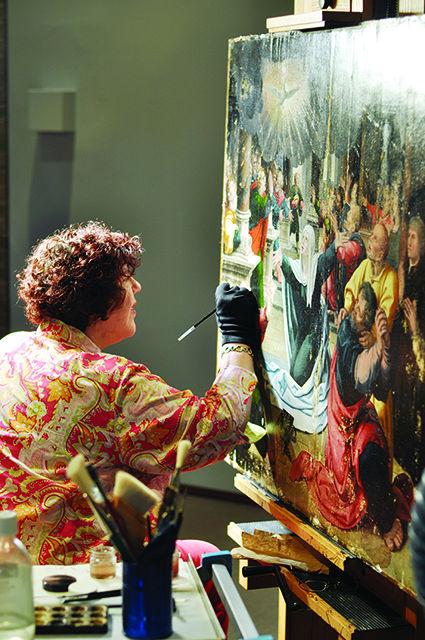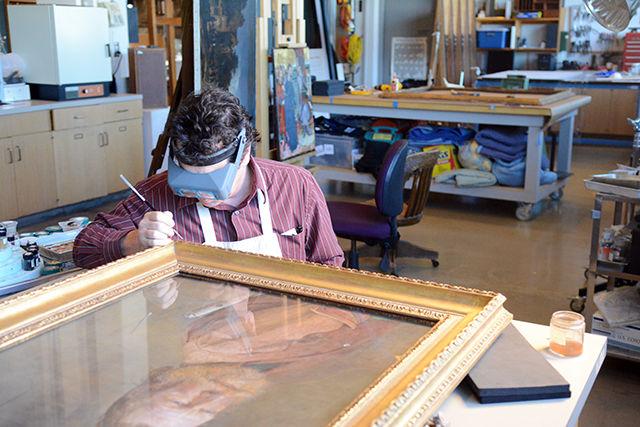An artist, a scientist, a historian and much more. Conservators at the North Carolina Museum of Art could be called Renaissance men much like the painters whose works they restore. The art and science of painting restoration will be on display to the public at the North Carolina Museum of Art from now until July 10 in “Actual State.”
“Conservation covers a lot of area,” said Perry Hurt, associate conservator at the North Carolina Museum of Art. “It combines a lot of different interests and skills.”
As conservators, Noelle Ocon, William Brown and Hurt work to restore, clean and preserve the artwork at the North Carolina Museum of Art. But this job title also entails a broad range of things from using infrared imaging to see beneath a painting, to repainting entire figures on paintings that were lost with time and wearing, to communicating with art owners and people who work in the museum.
Ocon began working on the new exhibit “Actual State” Saturday, where visitors are invited to watch her retouching two Flemish Paintings “The Ascension” and “The Pentecost,” both from 1530. The exhibit involves her “inpainting,” a process in which she applies her own paint to these masterpieces to recover damages and abrasions in front of an audience. Ocon describes the exhibit as “literally watching paint dry.”
However, art conservation is much more than simply watching paint dry. Brown is the chief conservator at the North Carolina Museum of Art, and he said that along with conserving, cleaning and preserving artwork, he caters to patrons, provides services to the public and other museums, does a lot of paper pushing, writes grants, works with budgets and does performance reviews.
Art conservation involves an abundance of science as well. The conservators have partnered with students and professors at NC State and Duke to collaborate on the science and technology behind conservation.
“Conservation is a science,” Ocon said. “It really was considered a craft until the ‘50s, and that was really when it became the science of conservation. And conservation is an umbrella term for preservation, documentation, examination and then restoration.”
The Art and Science Initiation was a relationship between the North Carolina Museum of Art and Duke University that allowed the museum access to technology and science while giving the students experience with interdisciplinary studies. Together they studied why materials degrade in paintings and how that relates to melanoma research they had conducted. They also studied different lasers and other art conservation tools like X-ray imaging in the program.
One of the projects that the museum’s conservation staff had was in collaboration with NC State’s chemistry and physics departments. Students identified red dye materials in paint pigments as an organic chemistry project, according to Hurt.
As conservators, they have had many challenging projects. Ocon, who primarily focuses on 15th to 17th century Flemish paintings, says her most challenging project was when she was working on “The Last Judgment,” painted by Crispijn van den Broeck. It had been painted on five different planks of wood and had cracked right down the middle. They had to restore the panels, meaning they had to break all of the panels apart and then glue them back together. Miraculously, the painting looked brand new afterward.
According to Brown, his most challenging project was on Bernando Belloto’s “View of Dresden with the Frauenkirche at Left.” The painting had two scenes and was missing an entire figure. The story that the painting was telling was not complete without this vital character, so Brown repainted an entire figure to complete an artist’s vision from all the way back in the 18th century.
“Some paintings are 600 years old, so they’ve been through a lot, been through wars, through many, many changes of hand and floods,” Brown said. “When you start cleaning the paintings, you try to know what’s coming and that we’ve examined everything thoroughly before we start. But, sometimes there are big surprises.”
The most challenging project for Hurt was when he worked on one of Claude Howell’s paintings. Howell is a North Carolina painter, and the painting that needed to be restored was a beach scene. The painting had a serious flaking problem, where fingernail-sized pieces were flaking off.
“[The North Carolina Museum of Art] is important because of its old master collection, particularly old master Italian paintings,” Brown said. “Therefore, well-equipped conservators are necessary. And now people have the opportunity to see the work they do with their own eyes with ‘Actual State.’”
Perry Hurt, an associate conservator at the North Carolina Museum of Art, works to touch up the frame of a painting in the conservation lab of the museum Friday. This painting, "Sea Dog," done by Andrew Newell Wyeth in 1971, was given to the museum by R.J. Reynolds Industries, Inc. Hurt, along with other conservators, will be restoring paintings where the public can observe the work in an exhibit called "Actual State,” which runs until July 10.









